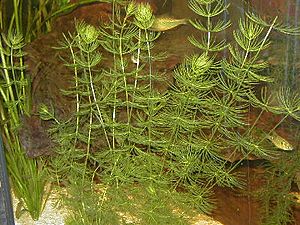Soft hornwort facts for kids
Quick facts for kids Soft hornwort |
|
|---|---|
 |
|
| Scientific classification | |
| Genus: |
Ceratophyllum
|
| Species: |
submersum
|
Ceratophyllum submersum, also called the soft hornwort or tropical hornwort, is a type of Ceratophyllum plant. It is an aquatic plant that floats freely underwater. You can find it in many places around the world, including Europe, Central Asia, northern Africa, Turkey, Oman, Florida, and the Dominican Republic. This plant is a bit like another underwater plant called Ceratophyllum demersum, which is found almost everywhere.
Contents
What is Soft Hornwort?
The soft hornwort, C. submersum, is a plant that floats freely in water. Its stems branch out three to four times. Each branch ends with 6 to 8 tips that look like thin threads. This makes C. submersum look more delicate than its cousin, C. demersum. The leaves of C. demersum only branch once or twice and have 3 to 4 tips.
This plant can live in water temperatures from 4°C to 30°C (about 39°F to 86°F). It grows best when the water is between 15°C and 30°C (about 59°F to 86°F). Soft hornwort plants usually grow to be 15-30 cm (6-12 inches) or even 30-45 cm (12-18 inches) tall.
Where Does Soft Hornwort Live?
C. submersum likes to grow in water that has a lot of nutrients, often near farms. This type of water is called eutrophic. Like Ceratophyllum demersum, the soft hornwort grows very quickly and can control its own growth.
It prefers places with a moderate amount of light. If there is too much light, C. submersum can turn a reddish-brown color. Adding carbon dioxide (CO2) can make it grow even faster, but it does not need CO2 to survive. Because it grows so fast, you might need to trim it often. Or, it needs a large space to grow properly, like a big fish tank.
This plant is found underwater in fresh water in warm parts of the world. It has also been introduced to new areas, such as Ireland. It has been seen in the Rosetta branch of the Nile River in Egypt, where it grows well at different times of the year.
How Soft Hornwort Affects Its Environment
When C. submersum is present in water, it can help reduce certain forms of nitrogen, like NH4 and NO3. At the same time, it can cause the water's pH to go up. It also increases the water's conductivity and the amount of dissolved oxygen.
Interestingly, C. demersum is often linked to a decrease in tiny water plants called phytoplankton. But C. submersum is linked to an increase in phytoplankton, chlorophyll a (which makes plants green), and Cyanophyceae (blue-green algae). Even though they are similar, C. submersum and C. demersum do not usually live in the exact same places. This shows they might prefer slightly different conditions. Sometimes, C. submersum can even take over an area from C. demersum in just one growing season.
How People Use Soft Hornwort
People often use C. submersum in aquariums. It helps to lower the amount of nitrogen in these artificial water systems. However, it is not as commonly used as C. demersum.
You can grow new soft hornwort plants by cutting a piece of the stem and placing it in water. This plant also helps clean wastewater. It takes organic matter (like waste) and helps turn it into simple, harmless substances. Then, it helps add oxygen to the water.
Images for kids



